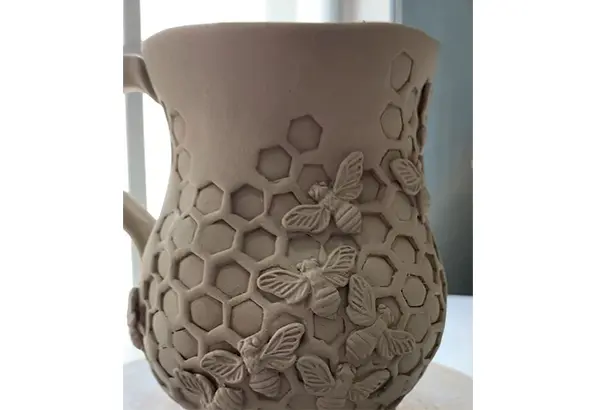cellulose etherOrganic additives are key in the injection molding process of honeycomb ceramics, and their role revolves around "improving the fluidity of the slurry, enhancing the performance of the green body, and ensuring the stability of the molding", which is specifically reflected in the following four core aspects:
1、 Adjust the fluidity of the slurry to ensure smooth grouting
The injection molding of honeycomb ceramics relies on the filling ability of the slurry (ceramic powder+water+additives) in the mold, while the thickening and pseudoplastic properties of cellulose ether are key:
Cellulose ether molecular chains bind with water molecules through hydrogen bonds, significantly increasing the viscosity of the slurry (for example, low viscosity hydroxypropyl methyl cellulose HPMC can increase the viscosity of the slurry from 100mPa · s to 500-1000mPa · s), preventing ceramic powder from settling and layering, and ensuring uniform and stable slurry.
Its pseudoplastic behavior of "shear thinning" (viscosity decreases when subjected to external shear and recovers when left to stand) can optimize grouting efficiency: during grouting, the viscosity of the slurry decreases under pressure or gravity, and it can quickly fill the complex pores of the mold (the grid structure of honeycomb ceramics is usually 0.5-2mm fine pores); After the grouting is completed, the viscosity is restored to prevent the slurry from leaking out of the mold gaps or deforming the pores.
2、 Enhance the strength of the billet and reduce molding defects
Honeycomb ceramic bodies have low strength during demolding and initial drying, and are prone to cracking and corner loss due to slight external forces (such as friction during demolding and shrinkage stress during drying). Cellulose ether can enhance the strength of the body through bonding and film-forming effects
cellulose etherMolecules are adsorbed on the surface of ceramic particles, and the particles are "bonded" into a whole through intermolecular forces, which increases the flexural strength of the wet body after grouting by 30% -50% (from 0.5MPa to 0.7-1.0MPa), ensuring the integrity of the body during demolding.
During the drying process, cellulose ether forms a tough film on the surface of the green body, which inhibits surface shrinkage and cracking caused by rapid evaporation of moisture, especially suitable for the forming requirements of honeycomb ceramic thin-walled (wall thickness 0.1-0.3mm) structures.
3、 Control moisture distribution and optimize drying process
The porous structure of honeycomb ceramics (with a porosity of up to 30% -60%) leads to a complex path for water evaporation during drying, which can result in uneven drying rates between the inside and outside (the outer layer has dried hard, while the inner layer is still wet), causing deformation or cracking of the body. The water retention of cellulose ether can alleviate this problem:
The hydroxyl groups (- OH) in its molecular chain form stable hydrogen bonds with water molecules, prolonging the retention time of water in the body (increasing water retention by 20% -40%), allowing water to slowly evaporate from the inside out, and reducing drying stress.
Water retention can also prevent the mold from expanding and deforming due to rapid water absorption (especially gypsum molds), extending the service life of the mold.
4、 Improve molding consistency and increase product qualification rate
Honeycomb ceramics require high dimensional accuracy (such as pore density and straightness), while cellulose ether reduces batch differences by stabilizing slurry properties
Inhibit the agglomeration of ceramic powder, make the slurry particles more evenly dispersed, ensure consistent density in all parts of the blank after grouting (density deviation can be controlled within ± 2%), and avoid deformation caused by uneven shrinkage after firing.
Its dosage (usually 0.2% -1.0% of the mass of ceramic powder) is easy to control, and can be accurately matched with the grouting requirements of different ceramic powders (such as cordierite and silicon carbide) by adjusting the addition amount, expanding the process adaptability.
summary
cellulose etherIn the injection molding of honeycomb ceramics, it plays multiple roles as a "rheological regulator+binder+water retaining agent". By optimizing the flowability of the slurry, enhancing the strength of the green body, and controlling the drying process, it ultimately ensures the complete molding and dimensional stability of the complex pore structure of honeycomb ceramics. It is an irreplaceable key additive in this process. The effectiveness of its action needs to be achieved through accurate control of the type (such as HPMC, CMC) and dosage. Excessive amounts may result in residual carbon impurities after firing, which needs to be optimized in conjunction with the firing process (such as high-temperature firing under oxidizing atmosphere).


TEL:+86 (0311) 8444 9786
Email:sales@double-bulls.com
Email:Export@double-bulls.com
Address:No.9 Weisi Road, Jinzhou City Eco-nomic Development Zone, Shijiazhuang City, Hebei Province.

Website

Brochure

Video